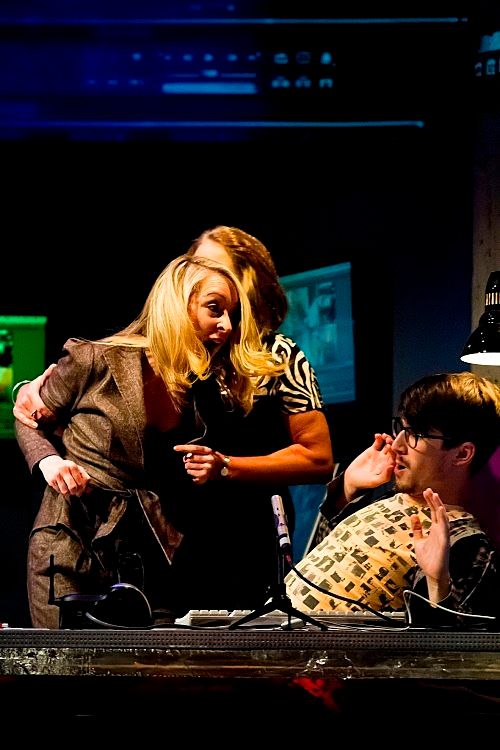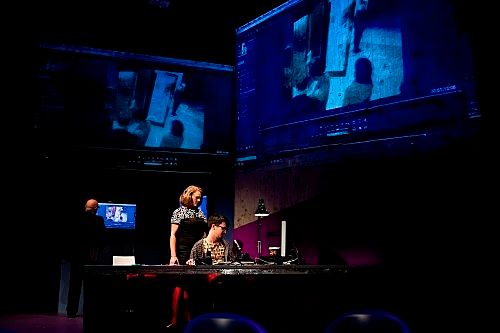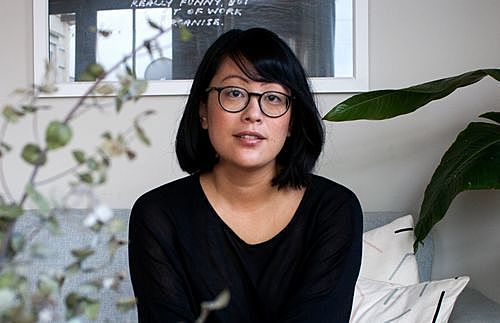Staging the Media Wars: An Interview with Leon Wadham
These are our newsrooms at their most self-destructive and cruel. With the latest iteration of Live of Six playing this week in Auckland, we talk to co-writer Leon Wadham about the show and how it's changed since its inception four years ago.
When TV1 news anchor Jane Kenyon first appears at the top of the stairs, nobody notices. She could be anyone. Another guest, a little late, one more to join the milling crowd in the foyer of the lower NZI. It’s only when she's stumbling down, clutching the metal railing for support, that heads turn. They turn quick. The guy to my right immediately pulls out his phone and starts filming her descent. Others approach the bottom of the stairs, curious. She’s clearly disoriented and visibly distressed, tottering wildly, stroking her stole fur. By the time she's reached the bottom, a crowd has formed, holding their phones and grinning widely at the scene unfolding before them. When she finally collapses at their feet, they don’t help. They keep filming. They keep grinning. It’s theatre, but it’s eerie. It’s the creation of Dean Hewison and Leon Wadham. It's Live at Six.
Written in 2009, the show was originally commissioned as part of the STAB initiative at Wellington’s BATS theatre. “Dean was working as an editor for a production company,” explains co-writer Leon Wadham. “He approached me with an idea for a play about editors working on a reality TV show, where the audience would watch as bland, raw footage was crafted into salacious content.”
As the concept evolved, the pair began looking beyond the consciously constructed nature of reality television. “We started looking at how our two major TV news programmes were doing their reporting and became increasingly interested in how each reported on the other. There were numerous local examples of newsmakers becoming news and then dealing with the situation very differently depending on whether their network stood to gain or to lose. We looked at the reporting on the announcement of Judy Bailey’s pay rise. We looked at their respective coverage of Darren McDonald. Then, when we were in the process of writing an outline, the Tony Veitch story broke.”
[caption id="attachment_8337" align="alignnone" width="500"] Photo: Philip Merry[/caption]
Live at Six chronicles the aftermath of the Jane Kenyon after-party collapse with each newsroom scrambling to find the angle that will best suit their agenda. TV1 want to save her; TV3 want to crucify her. The shots start cheap but they get progressively dirtier, culminating in a needlessly merciless end. The show raises some interesting questions around the demands we place on our broadcasters and the degree to which their private lives are public matters. Given the events under which this play was made, there's a nice tie-in too, almost like a post-script, with the recent appointment of Tony Veitch as Murray Deaker's successor on ZB and Radio Sport.
Despite the disheartening subject matter, it’s a light, fun show with a strong ensemble cast. The script is tight, the dialogue’s witty and sharp, and everything moves at Sorkin-like speed. As with all satire the best moments in this show are when the cast are enjoying themselves (the few earnest soapboxing episodes feel patronising and out of place) and the impressive use of technology – devious Skypes, live broadcasts, a cheeky Brooker-style deconstruction in the edit room – are seamlessly integrated to great comedic effect.
[caption id="attachment_8339" align="alignnone" width="500"] Photo: Philip Merry[/caption]
You also get to see the news being made: footage recorded from the foyer is cut live onstage and the audience is encouraged to tweet and send Vines during the show. “We’re very lucky to have our editors played by Eli Kent and Barnaby Fredric,” says Leon. “They’re good at assessing the content the audience sends through each night, then using that material to craft their stories.”
Given the improvisational nature of the edit, it’s inevitable that things will go wrong. “I’ve heard sickening stories of eleventh-hour saves. Barnaby had a problem with the audio on a crucial clip, so was sending Facebook messages to Eli arranging a cue point so that Eli could play the audio needed for the other actor’s final broadcast. They’re solving those kinds of problems while in the middle of scenes they’re performing in. I have no idea how they do it.”
[caption id="attachment_8338" align="alignnone" width="500"] Photo: Philip Merry[/caption]
It’s not just each performance that’s dependent on technology: the very existence of the show depends on it staying up-to-date. “Between the first and second season everybody purchased a smartphone. It changed the show completely. Live At Six has always been about a viral video taken at an after party, an anchor’s bad behaviour caught on tape, but back in 2009 a leak like that took serious effort. Somebody had to bring a Handycam to the event, go home, upload the thing. The show took on this “whodunit?” element that wasn’t really connected to the theme. A few years later when the second production was staged, that was all gone. Anybody in that room could’ve taken a video – maybe all of them did.”
They could have left it in its original form, allowing it to serve as a snapshot of a particular period in history, but by updating the show they’ve kept its energy focused on it being a teasing critique of mainstream news. In this way, Live at Six has evolved alongside news networks, each iteration tracking how technology is altering its practice, and this is a sentiment Leon echoes when I ask him what he’s learned from the experience. “Nothing’s ever finished,” he says simply. “You just run out of time.”
Live at Six plays at the Lower NZI, Aotea Centre from
12-16 November. Tickets $20-$35.




